Open Innovation: Benefits, Limitations, and Management Strategies
VerifiedAdded on 2023/01/05
|14
|4376
|74
Report
AI Summary
This report provides a comprehensive analysis of open innovation, a critical aspect of modern business strategy. It begins with an introduction to innovation management, defining its significance in fostering unique ideas and driving organizational change. The report then delves into the methodology employed to analyze open innovation, followed by a detailed exploration of the benefits and limitations associated with this approach. Benefits discussed include enhanced access to talent, new revenue streams, increased competitive advantage, cost reduction, and improved employee engagement. Conversely, the report identifies limitations such as unclear goals, diminishing returns, operational challenges, and difficulties in developing and implementing ideas. Real-world examples, such as Cisco and Samsung, are used to illustrate the practical application of open innovation. The report concludes with a critical evaluation of open innovation strategies, synthesizing the findings and offering recommendations for effective implementation. Overall, the report provides a valuable resource for understanding and leveraging open innovation in a business context.
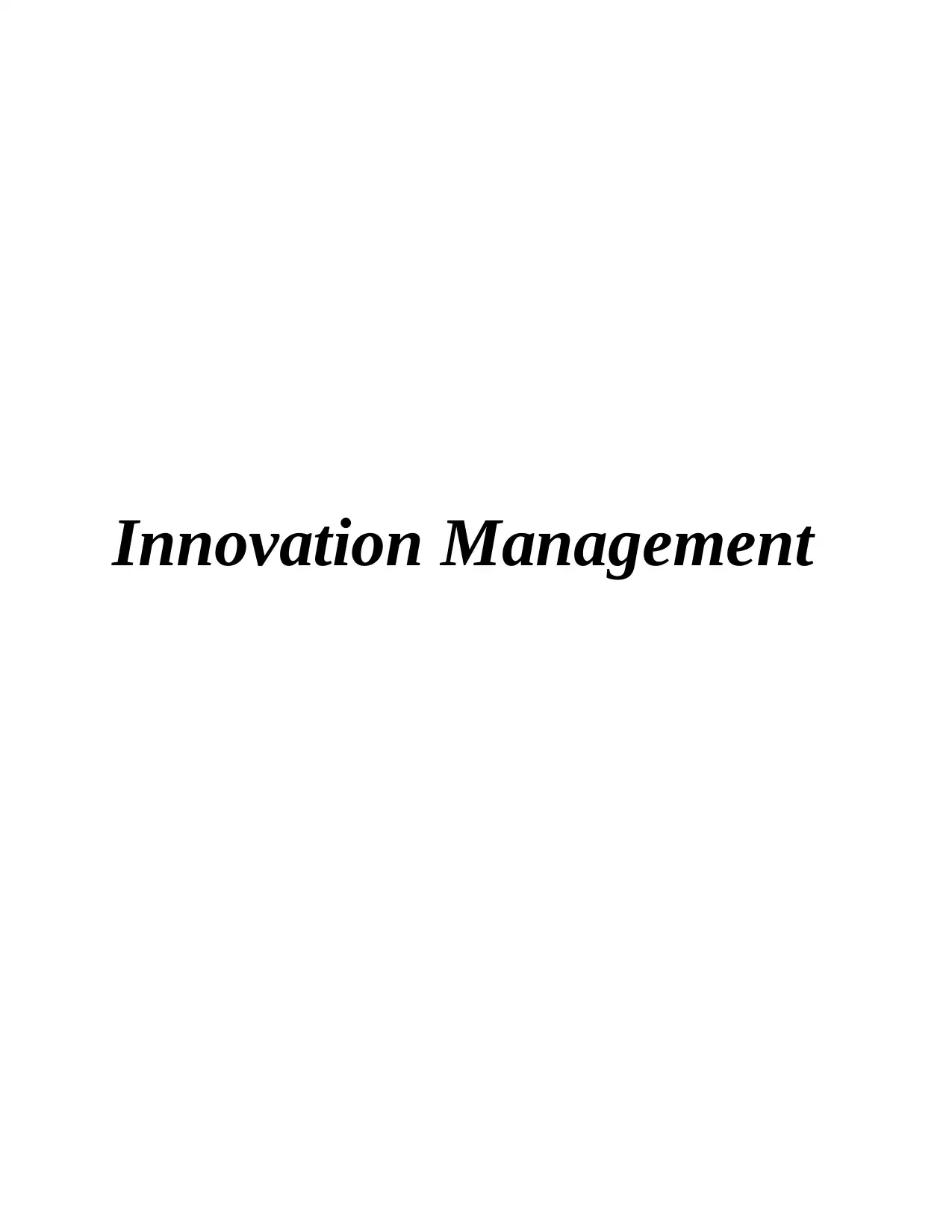
Innovation Management
Paraphrase This Document
Need a fresh take? Get an instant paraphrase of this document with our AI Paraphraser

Contents
INTRODUCTION.....................................................................................................................................3
Methodology of Analytical Approach......................................................................................................3
Innovation Management and its importance............................................................................................3
Benefits and Limitations of Open Innovation..........................................................................................4
Findings......................................................................................................................................................8
Critical evaluation...................................................................................................................................8
CONCLUSION........................................................................................................................................11
REFERENCES........................................................................................................................................12
INTRODUCTION.....................................................................................................................................3
Methodology of Analytical Approach......................................................................................................3
Innovation Management and its importance............................................................................................3
Benefits and Limitations of Open Innovation..........................................................................................4
Findings......................................................................................................................................................8
Critical evaluation...................................................................................................................................8
CONCLUSION........................................................................................................................................11
REFERENCES........................................................................................................................................12
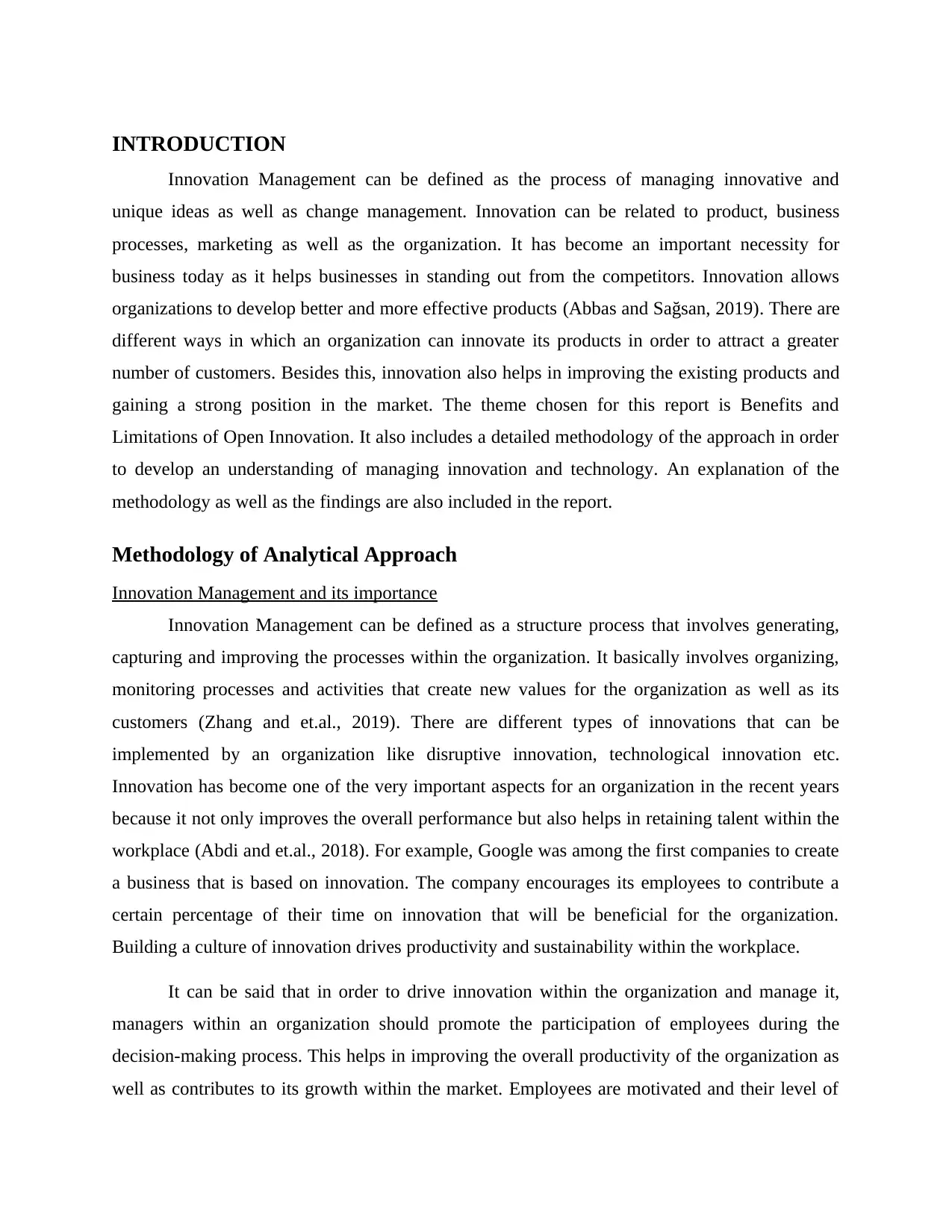
INTRODUCTION
Innovation Management can be defined as the process of managing innovative and
unique ideas as well as change management. Innovation can be related to product, business
processes, marketing as well as the organization. It has become an important necessity for
business today as it helps businesses in standing out from the competitors. Innovation allows
organizations to develop better and more effective products (Abbas and Sağsan, 2019). There are
different ways in which an organization can innovate its products in order to attract a greater
number of customers. Besides this, innovation also helps in improving the existing products and
gaining a strong position in the market. The theme chosen for this report is Benefits and
Limitations of Open Innovation. It also includes a detailed methodology of the approach in order
to develop an understanding of managing innovation and technology. An explanation of the
methodology as well as the findings are also included in the report.
Methodology of Analytical Approach
Innovation Management and its importance
Innovation Management can be defined as a structure process that involves generating,
capturing and improving the processes within the organization. It basically involves organizing,
monitoring processes and activities that create new values for the organization as well as its
customers (Zhang and et.al., 2019). There are different types of innovations that can be
implemented by an organization like disruptive innovation, technological innovation etc.
Innovation has become one of the very important aspects for an organization in the recent years
because it not only improves the overall performance but also helps in retaining talent within the
workplace (Abdi and et.al., 2018). For example, Google was among the first companies to create
a business that is based on innovation. The company encourages its employees to contribute a
certain percentage of their time on innovation that will be beneficial for the organization.
Building a culture of innovation drives productivity and sustainability within the workplace.
It can be said that in order to drive innovation within the organization and manage it,
managers within an organization should promote the participation of employees during the
decision-making process. This helps in improving the overall productivity of the organization as
well as contributes to its growth within the market. Employees are motivated and their level of
Innovation Management can be defined as the process of managing innovative and
unique ideas as well as change management. Innovation can be related to product, business
processes, marketing as well as the organization. It has become an important necessity for
business today as it helps businesses in standing out from the competitors. Innovation allows
organizations to develop better and more effective products (Abbas and Sağsan, 2019). There are
different ways in which an organization can innovate its products in order to attract a greater
number of customers. Besides this, innovation also helps in improving the existing products and
gaining a strong position in the market. The theme chosen for this report is Benefits and
Limitations of Open Innovation. It also includes a detailed methodology of the approach in order
to develop an understanding of managing innovation and technology. An explanation of the
methodology as well as the findings are also included in the report.
Methodology of Analytical Approach
Innovation Management and its importance
Innovation Management can be defined as a structure process that involves generating,
capturing and improving the processes within the organization. It basically involves organizing,
monitoring processes and activities that create new values for the organization as well as its
customers (Zhang and et.al., 2019). There are different types of innovations that can be
implemented by an organization like disruptive innovation, technological innovation etc.
Innovation has become one of the very important aspects for an organization in the recent years
because it not only improves the overall performance but also helps in retaining talent within the
workplace (Abdi and et.al., 2018). For example, Google was among the first companies to create
a business that is based on innovation. The company encourages its employees to contribute a
certain percentage of their time on innovation that will be beneficial for the organization.
Building a culture of innovation drives productivity and sustainability within the workplace.
It can be said that in order to drive innovation within the organization and manage it,
managers within an organization should promote the participation of employees during the
decision-making process. This helps in improving the overall productivity of the organization as
well as contributes to its growth within the market. Employees are motivated and their level of
⊘ This is a preview!⊘
Do you want full access?
Subscribe today to unlock all pages.

Trusted by 1+ million students worldwide
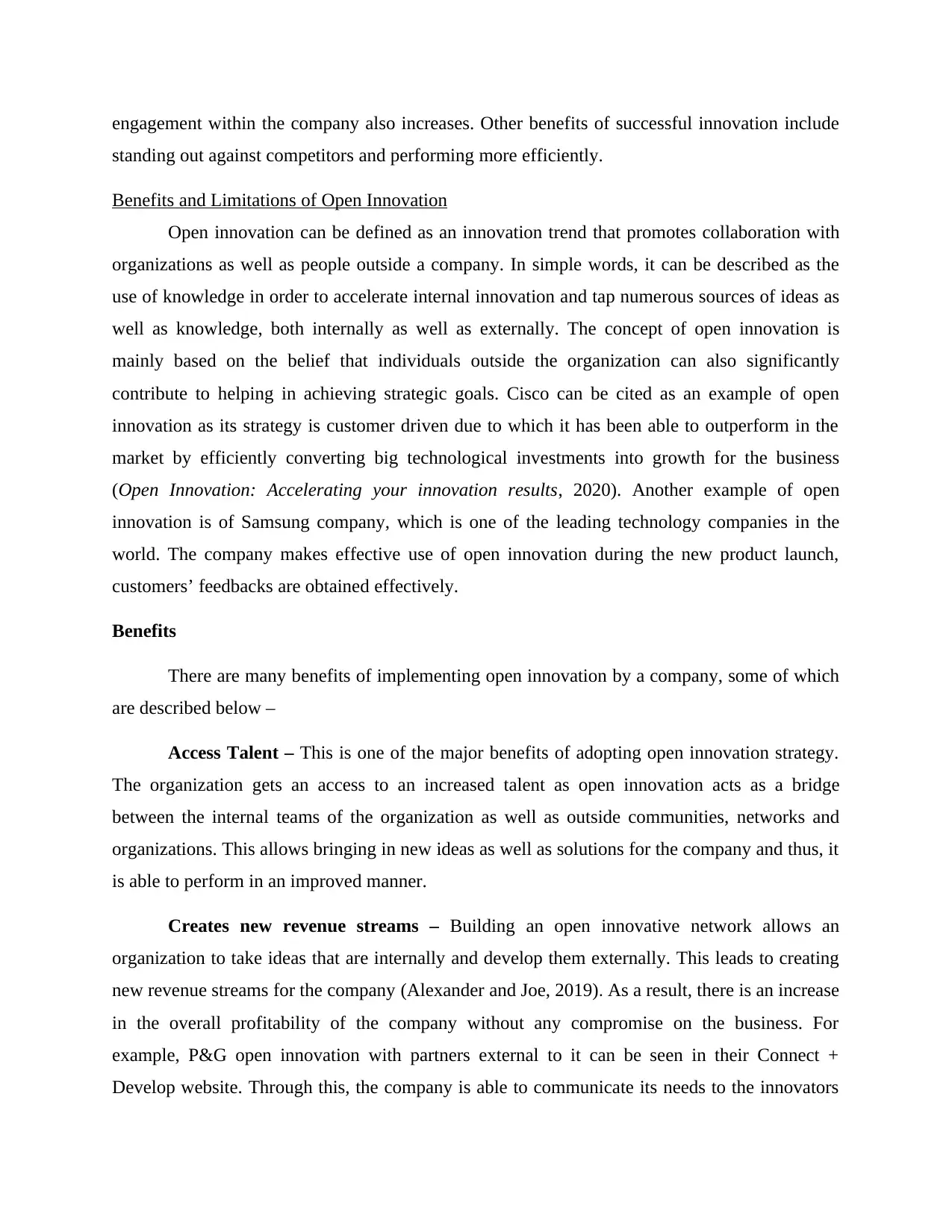
engagement within the company also increases. Other benefits of successful innovation include
standing out against competitors and performing more efficiently.
Benefits and Limitations of Open Innovation
Open innovation can be defined as an innovation trend that promotes collaboration with
organizations as well as people outside a company. In simple words, it can be described as the
use of knowledge in order to accelerate internal innovation and tap numerous sources of ideas as
well as knowledge, both internally as well as externally. The concept of open innovation is
mainly based on the belief that individuals outside the organization can also significantly
contribute to helping in achieving strategic goals. Cisco can be cited as an example of open
innovation as its strategy is customer driven due to which it has been able to outperform in the
market by efficiently converting big technological investments into growth for the business
(Open Innovation: Accelerating your innovation results, 2020). Another example of open
innovation is of Samsung company, which is one of the leading technology companies in the
world. The company makes effective use of open innovation during the new product launch,
customers’ feedbacks are obtained effectively.
Benefits
There are many benefits of implementing open innovation by a company, some of which
are described below –
Access Talent – This is one of the major benefits of adopting open innovation strategy.
The organization gets an access to an increased talent as open innovation acts as a bridge
between the internal teams of the organization as well as outside communities, networks and
organizations. This allows bringing in new ideas as well as solutions for the company and thus, it
is able to perform in an improved manner.
Creates new revenue streams – Building an open innovative network allows an
organization to take ideas that are internally and develop them externally. This leads to creating
new revenue streams for the company (Alexander and Joe, 2019). As a result, there is an increase
in the overall profitability of the company without any compromise on the business. For
example, P&G open innovation with partners external to it can be seen in their Connect +
Develop website. Through this, the company is able to communicate its needs to the innovators
standing out against competitors and performing more efficiently.
Benefits and Limitations of Open Innovation
Open innovation can be defined as an innovation trend that promotes collaboration with
organizations as well as people outside a company. In simple words, it can be described as the
use of knowledge in order to accelerate internal innovation and tap numerous sources of ideas as
well as knowledge, both internally as well as externally. The concept of open innovation is
mainly based on the belief that individuals outside the organization can also significantly
contribute to helping in achieving strategic goals. Cisco can be cited as an example of open
innovation as its strategy is customer driven due to which it has been able to outperform in the
market by efficiently converting big technological investments into growth for the business
(Open Innovation: Accelerating your innovation results, 2020). Another example of open
innovation is of Samsung company, which is one of the leading technology companies in the
world. The company makes effective use of open innovation during the new product launch,
customers’ feedbacks are obtained effectively.
Benefits
There are many benefits of implementing open innovation by a company, some of which
are described below –
Access Talent – This is one of the major benefits of adopting open innovation strategy.
The organization gets an access to an increased talent as open innovation acts as a bridge
between the internal teams of the organization as well as outside communities, networks and
organizations. This allows bringing in new ideas as well as solutions for the company and thus, it
is able to perform in an improved manner.
Creates new revenue streams – Building an open innovative network allows an
organization to take ideas that are internally and develop them externally. This leads to creating
new revenue streams for the company (Alexander and Joe, 2019). As a result, there is an increase
in the overall profitability of the company without any compromise on the business. For
example, P&G open innovation with partners external to it can be seen in their Connect +
Develop website. Through this, the company is able to communicate its needs to the innovators
Paraphrase This Document
Need a fresh take? Get an instant paraphrase of this document with our AI Paraphraser
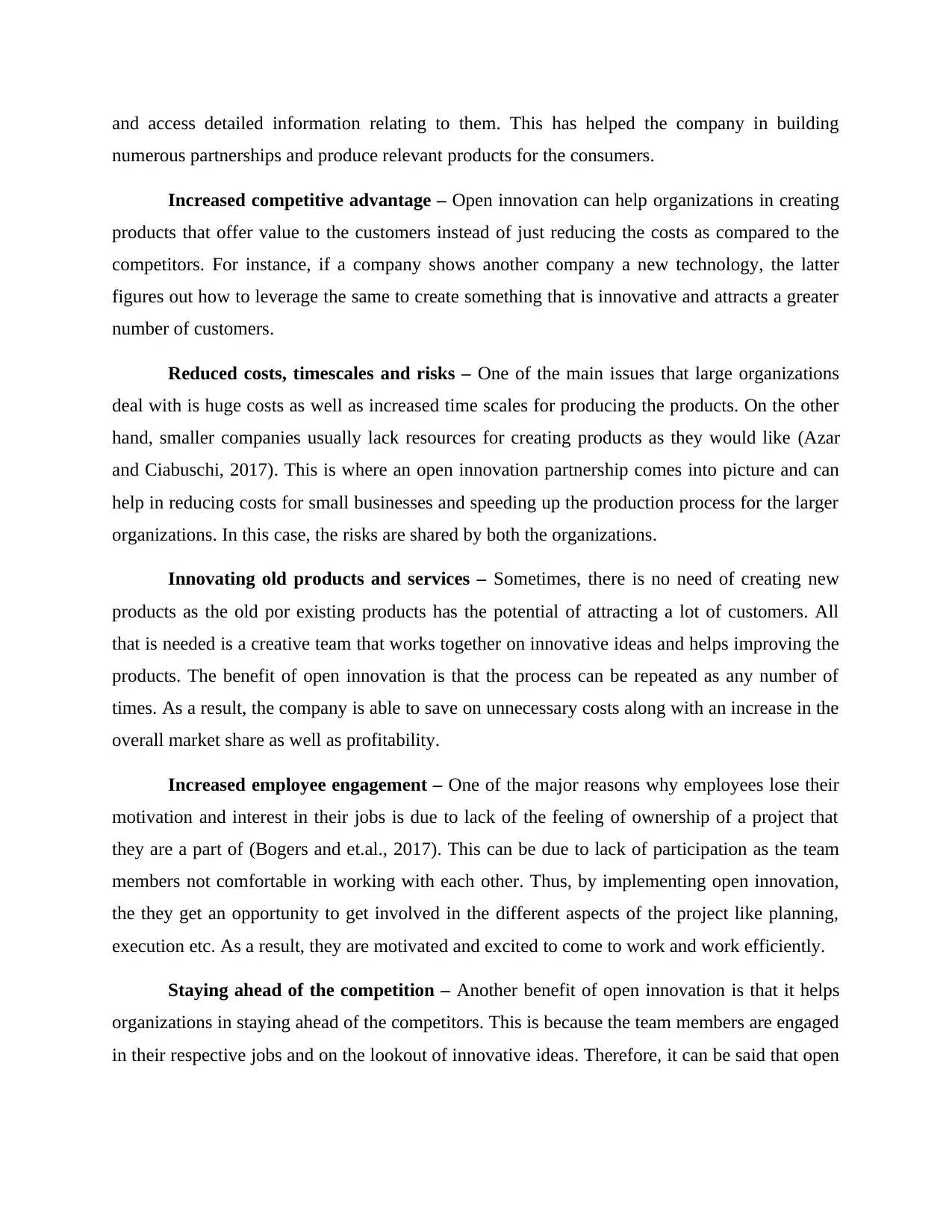
and access detailed information relating to them. This has helped the company in building
numerous partnerships and produce relevant products for the consumers.
Increased competitive advantage – Open innovation can help organizations in creating
products that offer value to the customers instead of just reducing the costs as compared to the
competitors. For instance, if a company shows another company a new technology, the latter
figures out how to leverage the same to create something that is innovative and attracts a greater
number of customers.
Reduced costs, timescales and risks – One of the main issues that large organizations
deal with is huge costs as well as increased time scales for producing the products. On the other
hand, smaller companies usually lack resources for creating products as they would like (Azar
and Ciabuschi, 2017). This is where an open innovation partnership comes into picture and can
help in reducing costs for small businesses and speeding up the production process for the larger
organizations. In this case, the risks are shared by both the organizations.
Innovating old products and services – Sometimes, there is no need of creating new
products as the old por existing products has the potential of attracting a lot of customers. All
that is needed is a creative team that works together on innovative ideas and helps improving the
products. The benefit of open innovation is that the process can be repeated as any number of
times. As a result, the company is able to save on unnecessary costs along with an increase in the
overall market share as well as profitability.
Increased employee engagement – One of the major reasons why employees lose their
motivation and interest in their jobs is due to lack of the feeling of ownership of a project that
they are a part of (Bogers and et.al., 2017). This can be due to lack of participation as the team
members not comfortable in working with each other. Thus, by implementing open innovation,
the they get an opportunity to get involved in the different aspects of the project like planning,
execution etc. As a result, they are motivated and excited to come to work and work efficiently.
Staying ahead of the competition – Another benefit of open innovation is that it helps
organizations in staying ahead of the competitors. This is because the team members are engaged
in their respective jobs and on the lookout of innovative ideas. Therefore, it can be said that open
numerous partnerships and produce relevant products for the consumers.
Increased competitive advantage – Open innovation can help organizations in creating
products that offer value to the customers instead of just reducing the costs as compared to the
competitors. For instance, if a company shows another company a new technology, the latter
figures out how to leverage the same to create something that is innovative and attracts a greater
number of customers.
Reduced costs, timescales and risks – One of the main issues that large organizations
deal with is huge costs as well as increased time scales for producing the products. On the other
hand, smaller companies usually lack resources for creating products as they would like (Azar
and Ciabuschi, 2017). This is where an open innovation partnership comes into picture and can
help in reducing costs for small businesses and speeding up the production process for the larger
organizations. In this case, the risks are shared by both the organizations.
Innovating old products and services – Sometimes, there is no need of creating new
products as the old por existing products has the potential of attracting a lot of customers. All
that is needed is a creative team that works together on innovative ideas and helps improving the
products. The benefit of open innovation is that the process can be repeated as any number of
times. As a result, the company is able to save on unnecessary costs along with an increase in the
overall market share as well as profitability.
Increased employee engagement – One of the major reasons why employees lose their
motivation and interest in their jobs is due to lack of the feeling of ownership of a project that
they are a part of (Bogers and et.al., 2017). This can be due to lack of participation as the team
members not comfortable in working with each other. Thus, by implementing open innovation,
the they get an opportunity to get involved in the different aspects of the project like planning,
execution etc. As a result, they are motivated and excited to come to work and work efficiently.
Staying ahead of the competition – Another benefit of open innovation is that it helps
organizations in staying ahead of the competitors. This is because the team members are engaged
in their respective jobs and on the lookout of innovative ideas. Therefore, it can be said that open
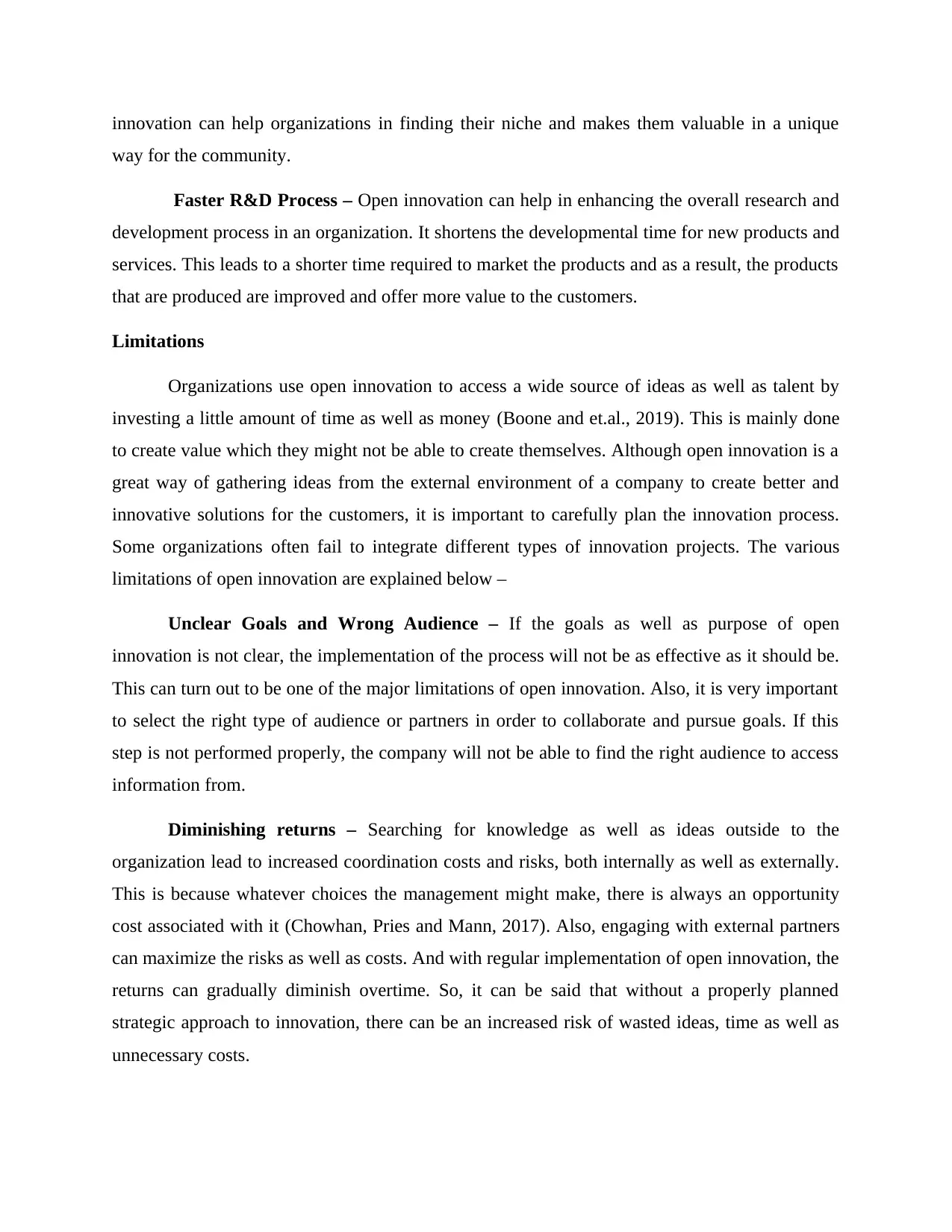
innovation can help organizations in finding their niche and makes them valuable in a unique
way for the community.
Faster R&D Process – Open innovation can help in enhancing the overall research and
development process in an organization. It shortens the developmental time for new products and
services. This leads to a shorter time required to market the products and as a result, the products
that are produced are improved and offer more value to the customers.
Limitations
Organizations use open innovation to access a wide source of ideas as well as talent by
investing a little amount of time as well as money (Boone and et.al., 2019). This is mainly done
to create value which they might not be able to create themselves. Although open innovation is a
great way of gathering ideas from the external environment of a company to create better and
innovative solutions for the customers, it is important to carefully plan the innovation process.
Some organizations often fail to integrate different types of innovation projects. The various
limitations of open innovation are explained below –
Unclear Goals and Wrong Audience – If the goals as well as purpose of open
innovation is not clear, the implementation of the process will not be as effective as it should be.
This can turn out to be one of the major limitations of open innovation. Also, it is very important
to select the right type of audience or partners in order to collaborate and pursue goals. If this
step is not performed properly, the company will not be able to find the right audience to access
information from.
Diminishing returns – Searching for knowledge as well as ideas outside to the
organization lead to increased coordination costs and risks, both internally as well as externally.
This is because whatever choices the management might make, there is always an opportunity
cost associated with it (Chowhan, Pries and Mann, 2017). Also, engaging with external partners
can maximize the risks as well as costs. And with regular implementation of open innovation, the
returns can gradually diminish overtime. So, it can be said that without a properly planned
strategic approach to innovation, there can be an increased risk of wasted ideas, time as well as
unnecessary costs.
way for the community.
Faster R&D Process – Open innovation can help in enhancing the overall research and
development process in an organization. It shortens the developmental time for new products and
services. This leads to a shorter time required to market the products and as a result, the products
that are produced are improved and offer more value to the customers.
Limitations
Organizations use open innovation to access a wide source of ideas as well as talent by
investing a little amount of time as well as money (Boone and et.al., 2019). This is mainly done
to create value which they might not be able to create themselves. Although open innovation is a
great way of gathering ideas from the external environment of a company to create better and
innovative solutions for the customers, it is important to carefully plan the innovation process.
Some organizations often fail to integrate different types of innovation projects. The various
limitations of open innovation are explained below –
Unclear Goals and Wrong Audience – If the goals as well as purpose of open
innovation is not clear, the implementation of the process will not be as effective as it should be.
This can turn out to be one of the major limitations of open innovation. Also, it is very important
to select the right type of audience or partners in order to collaborate and pursue goals. If this
step is not performed properly, the company will not be able to find the right audience to access
information from.
Diminishing returns – Searching for knowledge as well as ideas outside to the
organization lead to increased coordination costs and risks, both internally as well as externally.
This is because whatever choices the management might make, there is always an opportunity
cost associated with it (Chowhan, Pries and Mann, 2017). Also, engaging with external partners
can maximize the risks as well as costs. And with regular implementation of open innovation, the
returns can gradually diminish overtime. So, it can be said that without a properly planned
strategic approach to innovation, there can be an increased risk of wasted ideas, time as well as
unnecessary costs.
⊘ This is a preview!⊘
Do you want full access?
Subscribe today to unlock all pages.

Trusted by 1+ million students worldwide
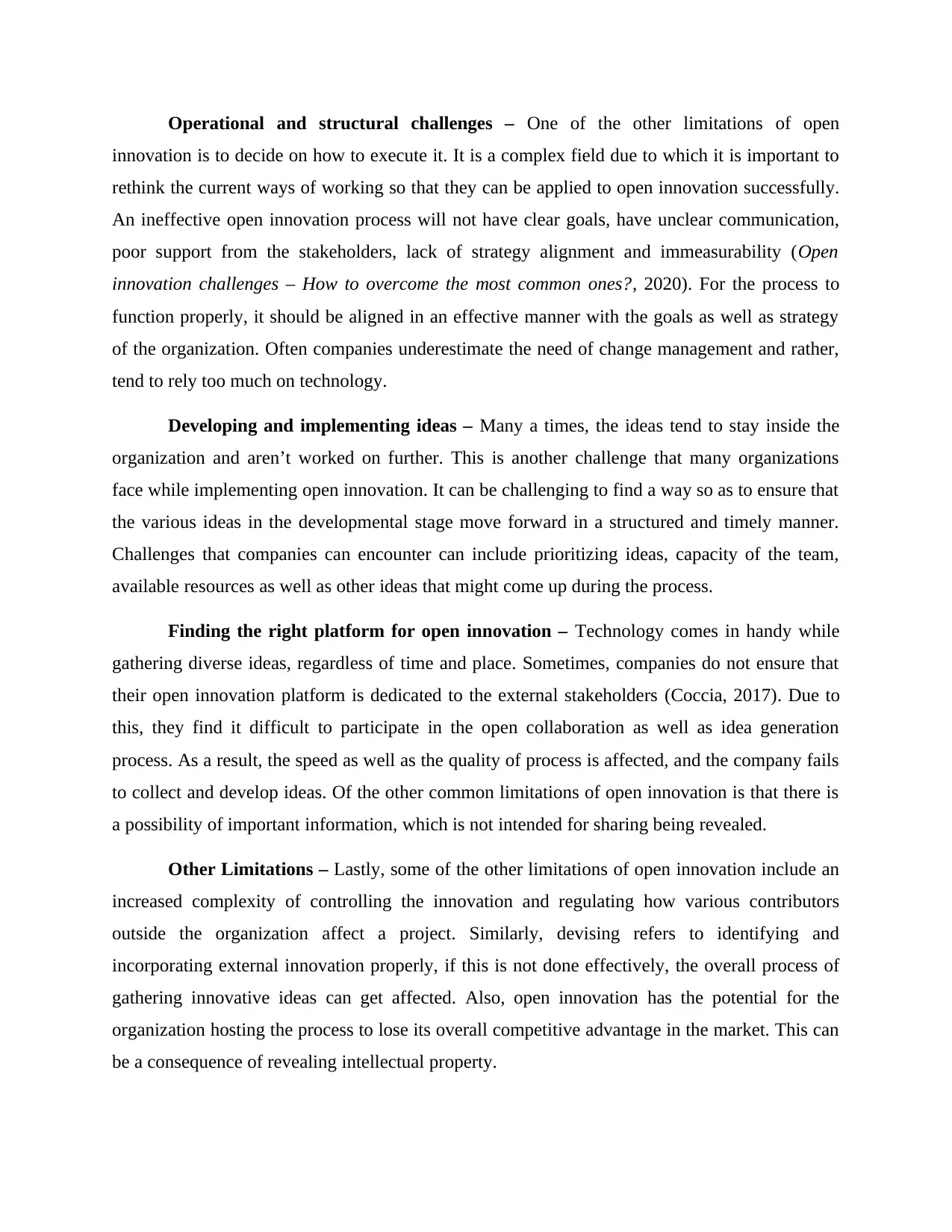
Operational and structural challenges – One of the other limitations of open
innovation is to decide on how to execute it. It is a complex field due to which it is important to
rethink the current ways of working so that they can be applied to open innovation successfully.
An ineffective open innovation process will not have clear goals, have unclear communication,
poor support from the stakeholders, lack of strategy alignment and immeasurability (Open
innovation challenges – How to overcome the most common ones?, 2020). For the process to
function properly, it should be aligned in an effective manner with the goals as well as strategy
of the organization. Often companies underestimate the need of change management and rather,
tend to rely too much on technology.
Developing and implementing ideas – Many a times, the ideas tend to stay inside the
organization and aren’t worked on further. This is another challenge that many organizations
face while implementing open innovation. It can be challenging to find a way so as to ensure that
the various ideas in the developmental stage move forward in a structured and timely manner.
Challenges that companies can encounter can include prioritizing ideas, capacity of the team,
available resources as well as other ideas that might come up during the process.
Finding the right platform for open innovation – Technology comes in handy while
gathering diverse ideas, regardless of time and place. Sometimes, companies do not ensure that
their open innovation platform is dedicated to the external stakeholders (Coccia, 2017). Due to
this, they find it difficult to participate in the open collaboration as well as idea generation
process. As a result, the speed as well as the quality of process is affected, and the company fails
to collect and develop ideas. Of the other common limitations of open innovation is that there is
a possibility of important information, which is not intended for sharing being revealed.
Other Limitations – Lastly, some of the other limitations of open innovation include an
increased complexity of controlling the innovation and regulating how various contributors
outside the organization affect a project. Similarly, devising refers to identifying and
incorporating external innovation properly, if this is not done effectively, the overall process of
gathering innovative ideas can get affected. Also, open innovation has the potential for the
organization hosting the process to lose its overall competitive advantage in the market. This can
be a consequence of revealing intellectual property.
innovation is to decide on how to execute it. It is a complex field due to which it is important to
rethink the current ways of working so that they can be applied to open innovation successfully.
An ineffective open innovation process will not have clear goals, have unclear communication,
poor support from the stakeholders, lack of strategy alignment and immeasurability (Open
innovation challenges – How to overcome the most common ones?, 2020). For the process to
function properly, it should be aligned in an effective manner with the goals as well as strategy
of the organization. Often companies underestimate the need of change management and rather,
tend to rely too much on technology.
Developing and implementing ideas – Many a times, the ideas tend to stay inside the
organization and aren’t worked on further. This is another challenge that many organizations
face while implementing open innovation. It can be challenging to find a way so as to ensure that
the various ideas in the developmental stage move forward in a structured and timely manner.
Challenges that companies can encounter can include prioritizing ideas, capacity of the team,
available resources as well as other ideas that might come up during the process.
Finding the right platform for open innovation – Technology comes in handy while
gathering diverse ideas, regardless of time and place. Sometimes, companies do not ensure that
their open innovation platform is dedicated to the external stakeholders (Coccia, 2017). Due to
this, they find it difficult to participate in the open collaboration as well as idea generation
process. As a result, the speed as well as the quality of process is affected, and the company fails
to collect and develop ideas. Of the other common limitations of open innovation is that there is
a possibility of important information, which is not intended for sharing being revealed.
Other Limitations – Lastly, some of the other limitations of open innovation include an
increased complexity of controlling the innovation and regulating how various contributors
outside the organization affect a project. Similarly, devising refers to identifying and
incorporating external innovation properly, if this is not done effectively, the overall process of
gathering innovative ideas can get affected. Also, open innovation has the potential for the
organization hosting the process to lose its overall competitive advantage in the market. This can
be a consequence of revealing intellectual property.
Paraphrase This Document
Need a fresh take? Get an instant paraphrase of this document with our AI Paraphraser
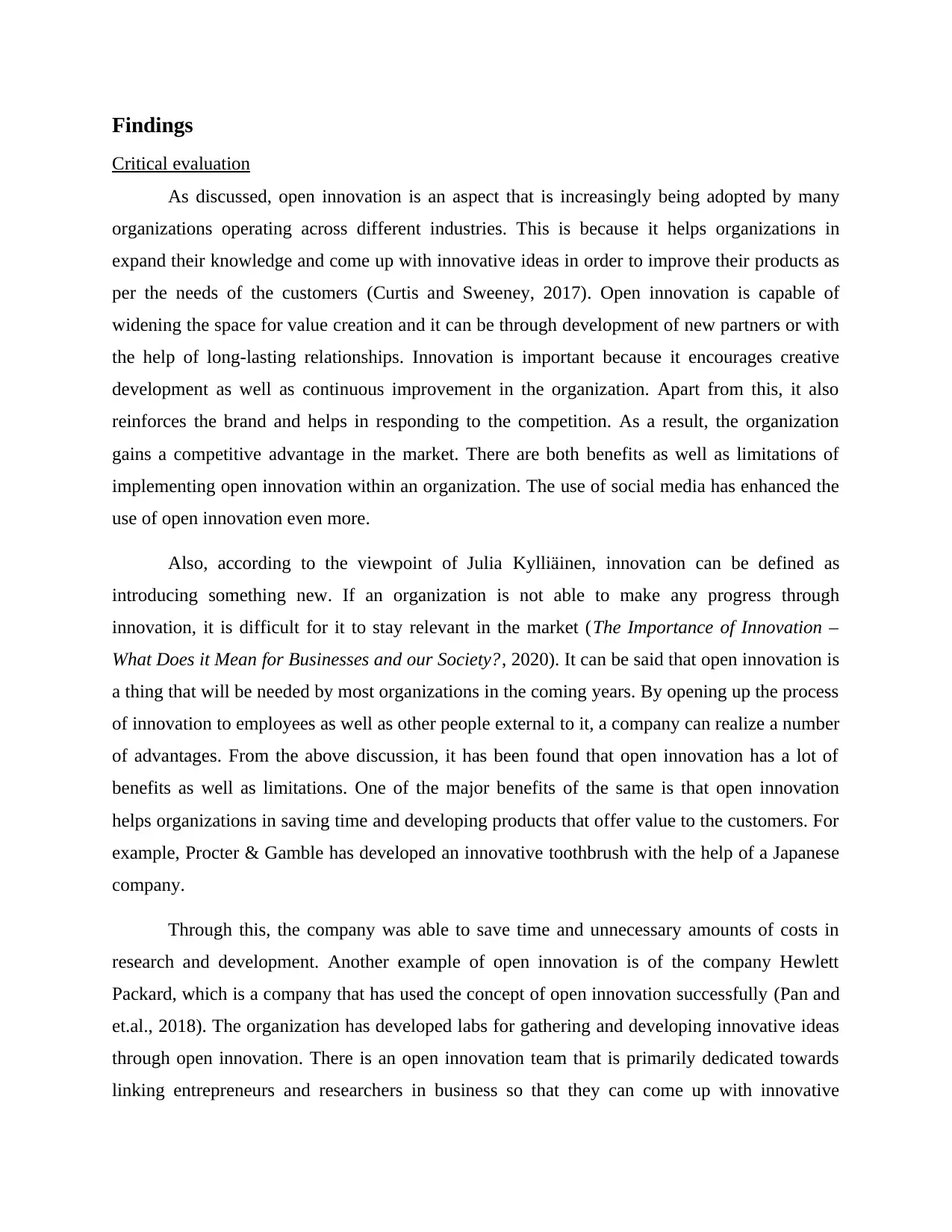
Findings
Critical evaluation
As discussed, open innovation is an aspect that is increasingly being adopted by many
organizations operating across different industries. This is because it helps organizations in
expand their knowledge and come up with innovative ideas in order to improve their products as
per the needs of the customers (Curtis and Sweeney, 2017). Open innovation is capable of
widening the space for value creation and it can be through development of new partners or with
the help of long-lasting relationships. Innovation is important because it encourages creative
development as well as continuous improvement in the organization. Apart from this, it also
reinforces the brand and helps in responding to the competition. As a result, the organization
gains a competitive advantage in the market. There are both benefits as well as limitations of
implementing open innovation within an organization. The use of social media has enhanced the
use of open innovation even more.
Also, according to the viewpoint of Julia Kylliäinen, innovation can be defined as
introducing something new. If an organization is not able to make any progress through
innovation, it is difficult for it to stay relevant in the market (The Importance of Innovation –
What Does it Mean for Businesses and our Society?, 2020). It can be said that open innovation is
a thing that will be needed by most organizations in the coming years. By opening up the process
of innovation to employees as well as other people external to it, a company can realize a number
of advantages. From the above discussion, it has been found that open innovation has a lot of
benefits as well as limitations. One of the major benefits of the same is that open innovation
helps organizations in saving time and developing products that offer value to the customers. For
example, Procter & Gamble has developed an innovative toothbrush with the help of a Japanese
company.
Through this, the company was able to save time and unnecessary amounts of costs in
research and development. Another example of open innovation is of the company Hewlett
Packard, which is a company that has used the concept of open innovation successfully (Pan and
et.al., 2018). The organization has developed labs for gathering and developing innovative ideas
through open innovation. There is an open innovation team that is primarily dedicated towards
linking entrepreneurs and researchers in business so that they can come up with innovative
Critical evaluation
As discussed, open innovation is an aspect that is increasingly being adopted by many
organizations operating across different industries. This is because it helps organizations in
expand their knowledge and come up with innovative ideas in order to improve their products as
per the needs of the customers (Curtis and Sweeney, 2017). Open innovation is capable of
widening the space for value creation and it can be through development of new partners or with
the help of long-lasting relationships. Innovation is important because it encourages creative
development as well as continuous improvement in the organization. Apart from this, it also
reinforces the brand and helps in responding to the competition. As a result, the organization
gains a competitive advantage in the market. There are both benefits as well as limitations of
implementing open innovation within an organization. The use of social media has enhanced the
use of open innovation even more.
Also, according to the viewpoint of Julia Kylliäinen, innovation can be defined as
introducing something new. If an organization is not able to make any progress through
innovation, it is difficult for it to stay relevant in the market (The Importance of Innovation –
What Does it Mean for Businesses and our Society?, 2020). It can be said that open innovation is
a thing that will be needed by most organizations in the coming years. By opening up the process
of innovation to employees as well as other people external to it, a company can realize a number
of advantages. From the above discussion, it has been found that open innovation has a lot of
benefits as well as limitations. One of the major benefits of the same is that open innovation
helps organizations in saving time and developing products that offer value to the customers. For
example, Procter & Gamble has developed an innovative toothbrush with the help of a Japanese
company.
Through this, the company was able to save time and unnecessary amounts of costs in
research and development. Another example of open innovation is of the company Hewlett
Packard, which is a company that has used the concept of open innovation successfully (Pan and
et.al., 2018). The organization has developed labs for gathering and developing innovative ideas
through open innovation. There is an open innovation team that is primarily dedicated towards
linking entrepreneurs and researchers in business so that they can come up with innovative
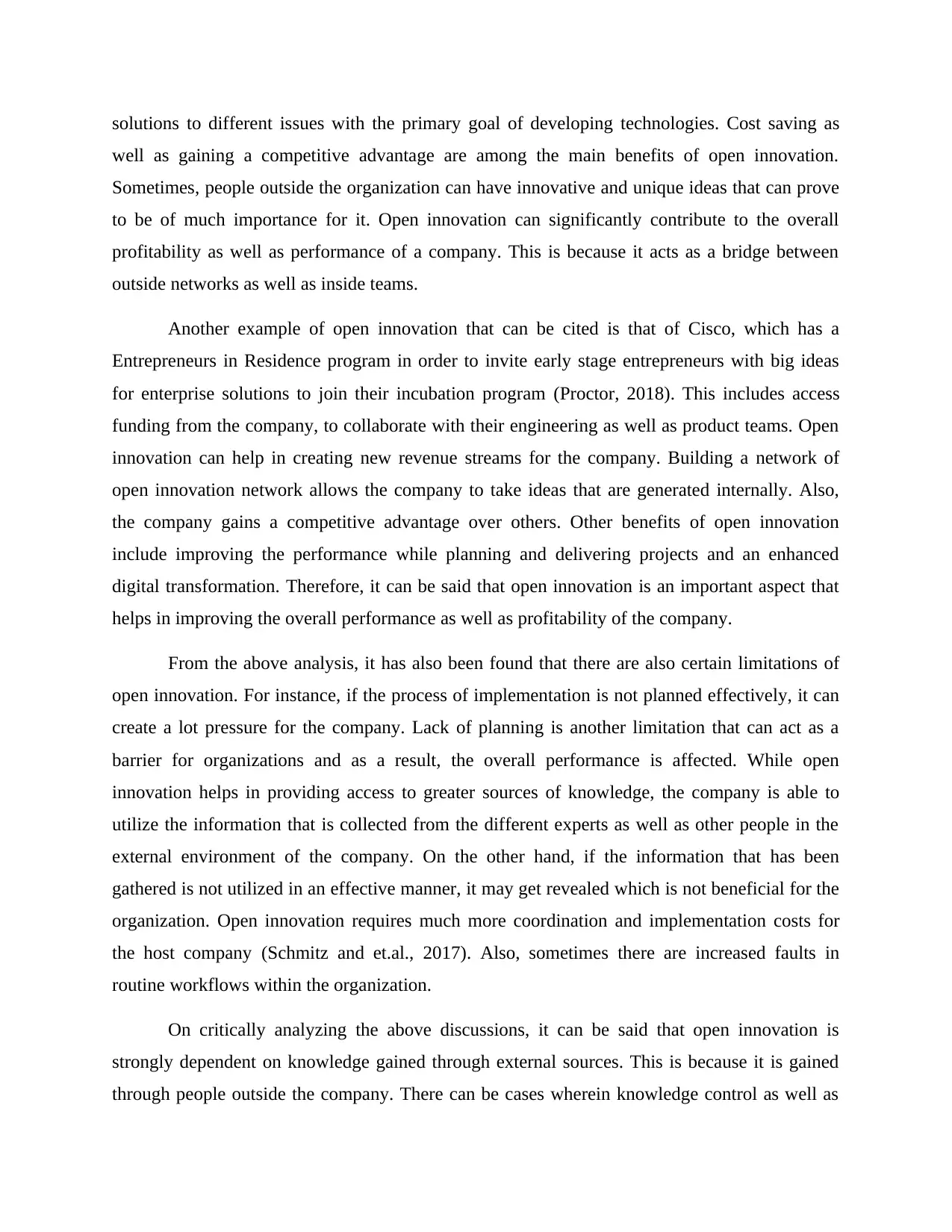
solutions to different issues with the primary goal of developing technologies. Cost saving as
well as gaining a competitive advantage are among the main benefits of open innovation.
Sometimes, people outside the organization can have innovative and unique ideas that can prove
to be of much importance for it. Open innovation can significantly contribute to the overall
profitability as well as performance of a company. This is because it acts as a bridge between
outside networks as well as inside teams.
Another example of open innovation that can be cited is that of Cisco, which has a
Entrepreneurs in Residence program in order to invite early stage entrepreneurs with big ideas
for enterprise solutions to join their incubation program (Proctor, 2018). This includes access
funding from the company, to collaborate with their engineering as well as product teams. Open
innovation can help in creating new revenue streams for the company. Building a network of
open innovation network allows the company to take ideas that are generated internally. Also,
the company gains a competitive advantage over others. Other benefits of open innovation
include improving the performance while planning and delivering projects and an enhanced
digital transformation. Therefore, it can be said that open innovation is an important aspect that
helps in improving the overall performance as well as profitability of the company.
From the above analysis, it has also been found that there are also certain limitations of
open innovation. For instance, if the process of implementation is not planned effectively, it can
create a lot pressure for the company. Lack of planning is another limitation that can act as a
barrier for organizations and as a result, the overall performance is affected. While open
innovation helps in providing access to greater sources of knowledge, the company is able to
utilize the information that is collected from the different experts as well as other people in the
external environment of the company. On the other hand, if the information that has been
gathered is not utilized in an effective manner, it may get revealed which is not beneficial for the
organization. Open innovation requires much more coordination and implementation costs for
the host company (Schmitz and et.al., 2017). Also, sometimes there are increased faults in
routine workflows within the organization.
On critically analyzing the above discussions, it can be said that open innovation is
strongly dependent on knowledge gained through external sources. This is because it is gained
through people outside the company. There can be cases wherein knowledge control as well as
well as gaining a competitive advantage are among the main benefits of open innovation.
Sometimes, people outside the organization can have innovative and unique ideas that can prove
to be of much importance for it. Open innovation can significantly contribute to the overall
profitability as well as performance of a company. This is because it acts as a bridge between
outside networks as well as inside teams.
Another example of open innovation that can be cited is that of Cisco, which has a
Entrepreneurs in Residence program in order to invite early stage entrepreneurs with big ideas
for enterprise solutions to join their incubation program (Proctor, 2018). This includes access
funding from the company, to collaborate with their engineering as well as product teams. Open
innovation can help in creating new revenue streams for the company. Building a network of
open innovation network allows the company to take ideas that are generated internally. Also,
the company gains a competitive advantage over others. Other benefits of open innovation
include improving the performance while planning and delivering projects and an enhanced
digital transformation. Therefore, it can be said that open innovation is an important aspect that
helps in improving the overall performance as well as profitability of the company.
From the above analysis, it has also been found that there are also certain limitations of
open innovation. For instance, if the process of implementation is not planned effectively, it can
create a lot pressure for the company. Lack of planning is another limitation that can act as a
barrier for organizations and as a result, the overall performance is affected. While open
innovation helps in providing access to greater sources of knowledge, the company is able to
utilize the information that is collected from the different experts as well as other people in the
external environment of the company. On the other hand, if the information that has been
gathered is not utilized in an effective manner, it may get revealed which is not beneficial for the
organization. Open innovation requires much more coordination and implementation costs for
the host company (Schmitz and et.al., 2017). Also, sometimes there are increased faults in
routine workflows within the organization.
On critically analyzing the above discussions, it can be said that open innovation is
strongly dependent on knowledge gained through external sources. This is because it is gained
through people outside the company. There can be cases wherein knowledge control as well as
⊘ This is a preview!⊘
Do you want full access?
Subscribe today to unlock all pages.

Trusted by 1+ million students worldwide
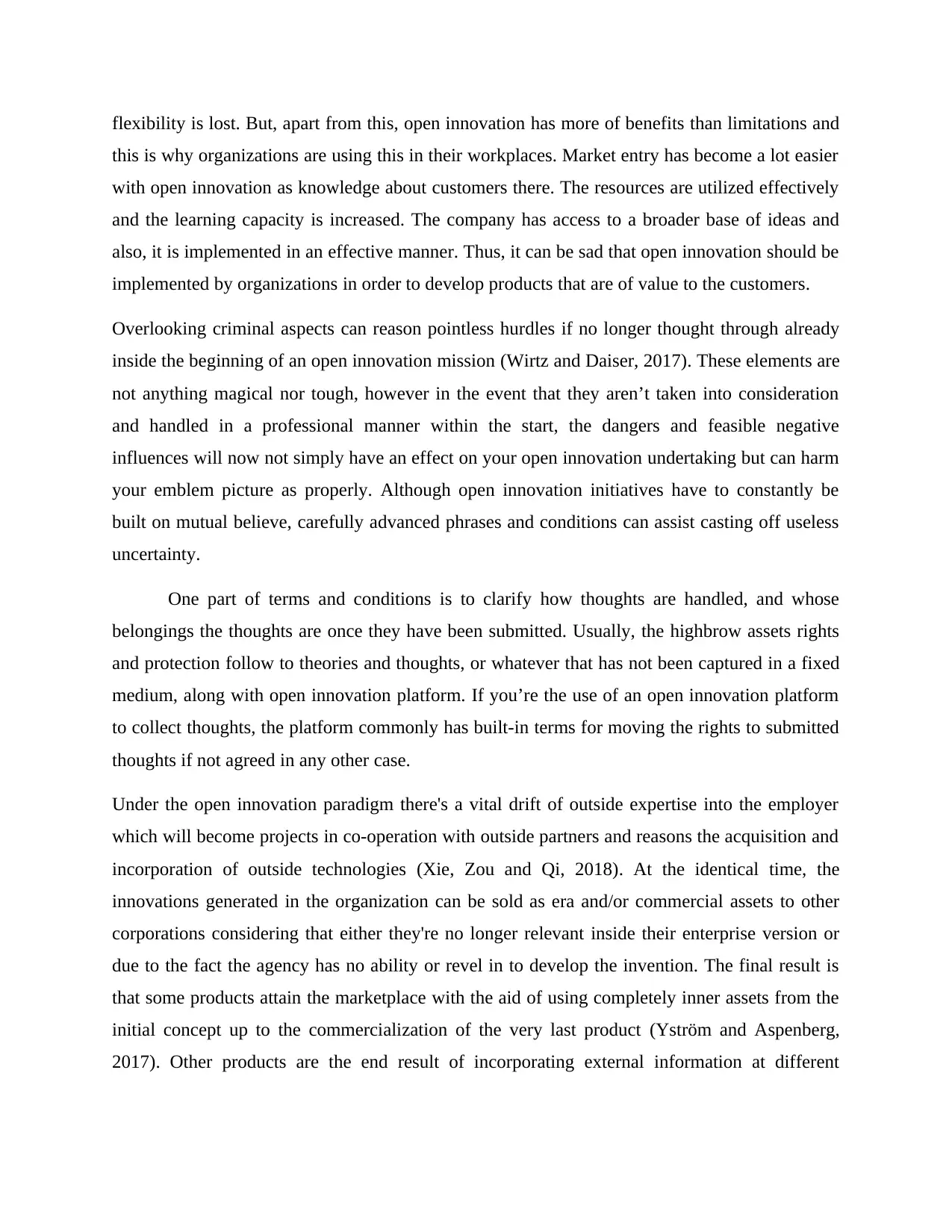
flexibility is lost. But, apart from this, open innovation has more of benefits than limitations and
this is why organizations are using this in their workplaces. Market entry has become a lot easier
with open innovation as knowledge about customers there. The resources are utilized effectively
and the learning capacity is increased. The company has access to a broader base of ideas and
also, it is implemented in an effective manner. Thus, it can be sad that open innovation should be
implemented by organizations in order to develop products that are of value to the customers.
Overlooking criminal aspects can reason pointless hurdles if no longer thought through already
inside the beginning of an open innovation mission (Wirtz and Daiser, 2017). These elements are
not anything magical nor tough, however in the event that they aren’t taken into consideration
and handled in a professional manner within the start, the dangers and feasible negative
influences will now not simply have an effect on your open innovation undertaking but can harm
your emblem picture as properly. Although open innovation initiatives have to constantly be
built on mutual believe, carefully advanced phrases and conditions can assist casting off useless
uncertainty.
One part of terms and conditions is to clarify how thoughts are handled, and whose
belongings the thoughts are once they have been submitted. Usually, the highbrow assets rights
and protection follow to theories and thoughts, or whatever that has not been captured in a fixed
medium, along with open innovation platform. If you’re the use of an open innovation platform
to collect thoughts, the platform commonly has built-in terms for moving the rights to submitted
thoughts if not agreed in any other case.
Under the open innovation paradigm there's a vital drift of outside expertise into the employer
which will become projects in co-operation with outside partners and reasons the acquisition and
incorporation of outside technologies (Xie, Zou and Qi, 2018). At the identical time, the
innovations generated in the organization can be sold as era and/or commercial assets to other
corporations considering that either they're no longer relevant inside their enterprise version or
due to the fact the agency has no ability or revel in to develop the invention. The final result is
that some products attain the marketplace with the aid of using completely inner assets from the
initial concept up to the commercialization of the very last product (Yström and Aspenberg,
2017). Other products are the end result of incorporating external information at different
this is why organizations are using this in their workplaces. Market entry has become a lot easier
with open innovation as knowledge about customers there. The resources are utilized effectively
and the learning capacity is increased. The company has access to a broader base of ideas and
also, it is implemented in an effective manner. Thus, it can be sad that open innovation should be
implemented by organizations in order to develop products that are of value to the customers.
Overlooking criminal aspects can reason pointless hurdles if no longer thought through already
inside the beginning of an open innovation mission (Wirtz and Daiser, 2017). These elements are
not anything magical nor tough, however in the event that they aren’t taken into consideration
and handled in a professional manner within the start, the dangers and feasible negative
influences will now not simply have an effect on your open innovation undertaking but can harm
your emblem picture as properly. Although open innovation initiatives have to constantly be
built on mutual believe, carefully advanced phrases and conditions can assist casting off useless
uncertainty.
One part of terms and conditions is to clarify how thoughts are handled, and whose
belongings the thoughts are once they have been submitted. Usually, the highbrow assets rights
and protection follow to theories and thoughts, or whatever that has not been captured in a fixed
medium, along with open innovation platform. If you’re the use of an open innovation platform
to collect thoughts, the platform commonly has built-in terms for moving the rights to submitted
thoughts if not agreed in any other case.
Under the open innovation paradigm there's a vital drift of outside expertise into the employer
which will become projects in co-operation with outside partners and reasons the acquisition and
incorporation of outside technologies (Xie, Zou and Qi, 2018). At the identical time, the
innovations generated in the organization can be sold as era and/or commercial assets to other
corporations considering that either they're no longer relevant inside their enterprise version or
due to the fact the agency has no ability or revel in to develop the invention. The final result is
that some products attain the marketplace with the aid of using completely inner assets from the
initial concept up to the commercialization of the very last product (Yström and Aspenberg,
2017). Other products are the end result of incorporating external information at different
Paraphrase This Document
Need a fresh take? Get an instant paraphrase of this document with our AI Paraphraser

degrees of their development. Therefore, it can be said that open innovation is an important
aspect that if implemented, can help in improving the performance of the company.
aspect that if implemented, can help in improving the performance of the company.
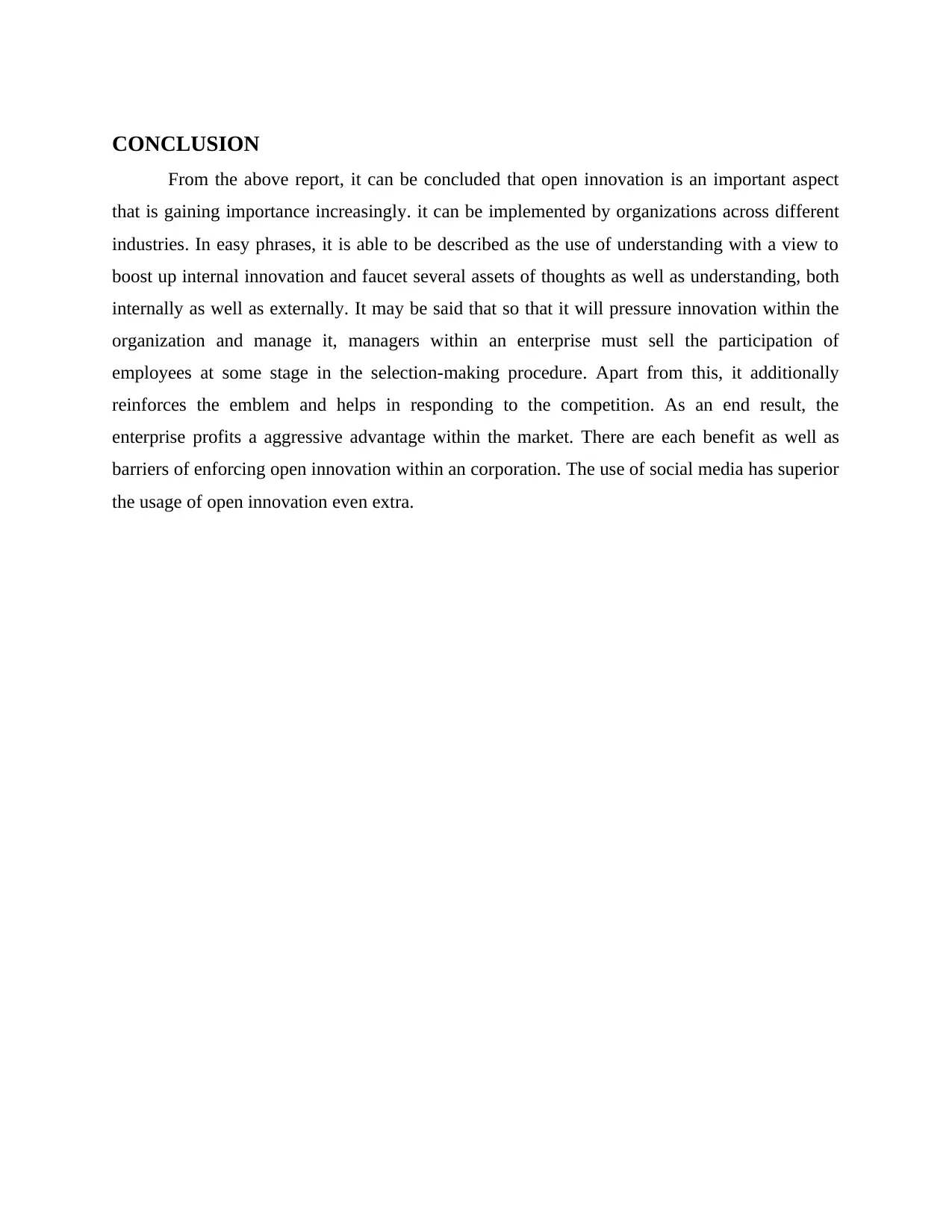
CONCLUSION
From the above report, it can be concluded that open innovation is an important aspect
that is gaining importance increasingly. it can be implemented by organizations across different
industries. In easy phrases, it is able to be described as the use of understanding with a view to
boost up internal innovation and faucet several assets of thoughts as well as understanding, both
internally as well as externally. It may be said that so that it will pressure innovation within the
organization and manage it, managers within an enterprise must sell the participation of
employees at some stage in the selection-making procedure. Apart from this, it additionally
reinforces the emblem and helps in responding to the competition. As an end result, the
enterprise profits a aggressive advantage within the market. There are each benefit as well as
barriers of enforcing open innovation within an corporation. The use of social media has superior
the usage of open innovation even extra.
From the above report, it can be concluded that open innovation is an important aspect
that is gaining importance increasingly. it can be implemented by organizations across different
industries. In easy phrases, it is able to be described as the use of understanding with a view to
boost up internal innovation and faucet several assets of thoughts as well as understanding, both
internally as well as externally. It may be said that so that it will pressure innovation within the
organization and manage it, managers within an enterprise must sell the participation of
employees at some stage in the selection-making procedure. Apart from this, it additionally
reinforces the emblem and helps in responding to the competition. As an end result, the
enterprise profits a aggressive advantage within the market. There are each benefit as well as
barriers of enforcing open innovation within an corporation. The use of social media has superior
the usage of open innovation even extra.
⊘ This is a preview!⊘
Do you want full access?
Subscribe today to unlock all pages.

Trusted by 1+ million students worldwide
1 out of 14
Related Documents
Your All-in-One AI-Powered Toolkit for Academic Success.
+13062052269
info@desklib.com
Available 24*7 on WhatsApp / Email
![[object Object]](/_next/static/media/star-bottom.7253800d.svg)
Unlock your academic potential
Copyright © 2020–2025 A2Z Services. All Rights Reserved. Developed and managed by ZUCOL.





